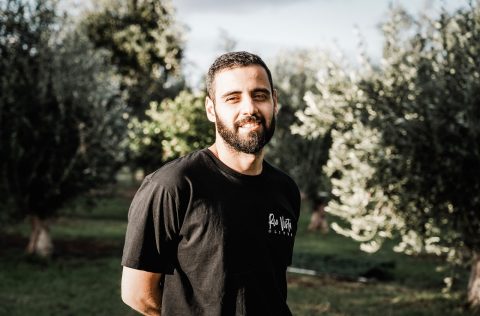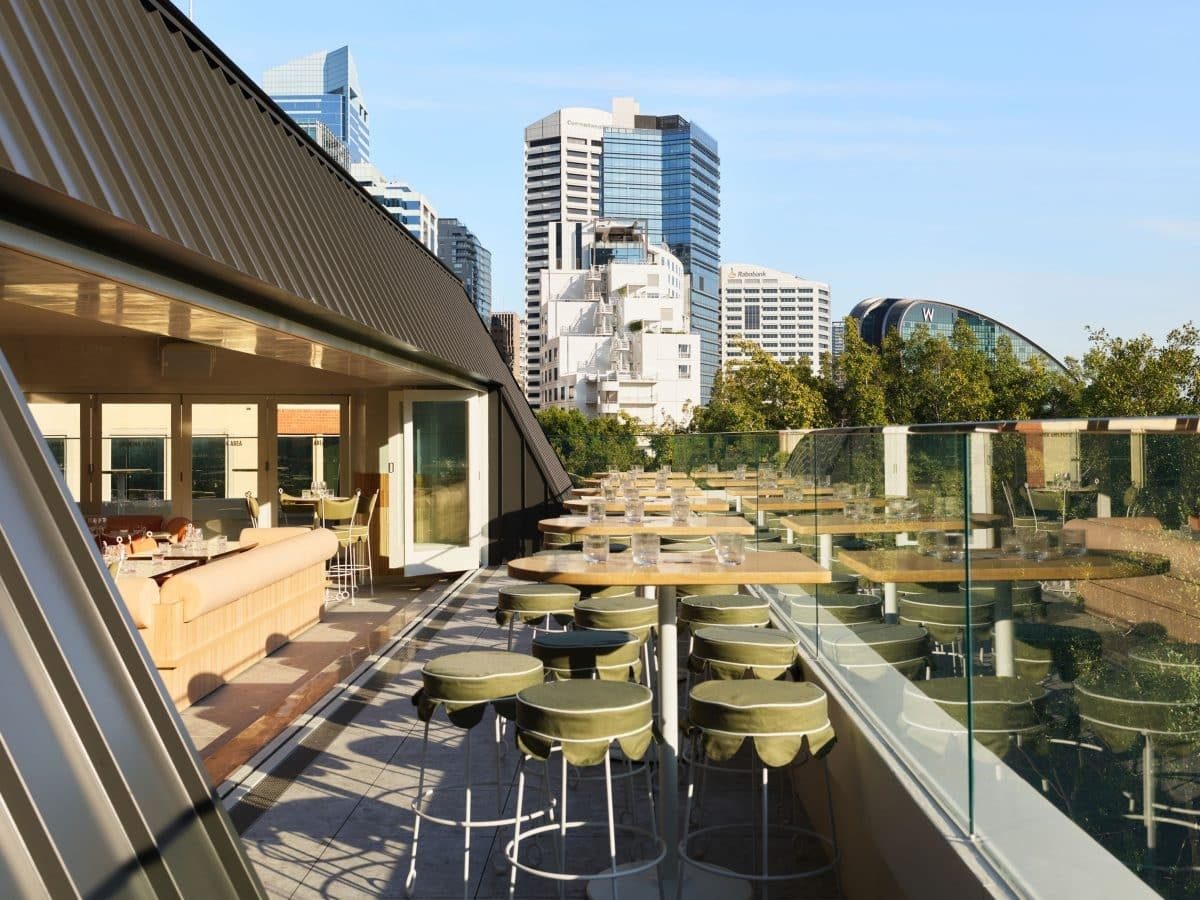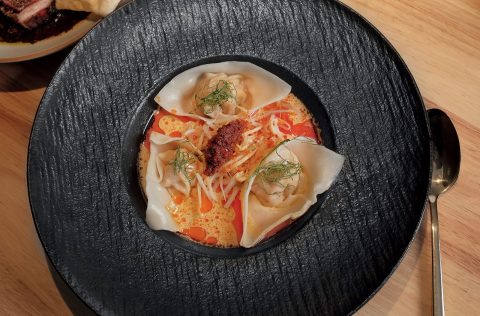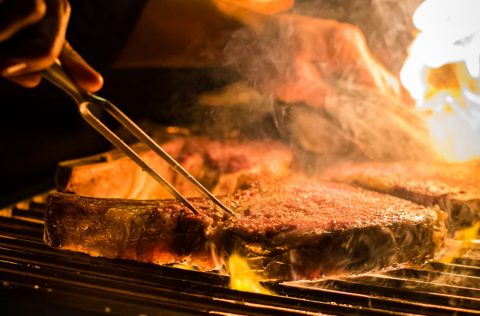The Chef and Producer Partnerships Producing World-class Dishes
If a chef is only as good as their ingredients, getting to know the producers is essential. In these successful partnerships, the proof is in the eating.
If you happen to catch chef Paul Farag off duty, it’s entirely possible he’ll be wearing a Rio Vista Olives sweatshirt. Although he now creates his own personal blend with the brand’s co-owner Sarah Asciutto, he has no formal endorsement deal with the family-run South Australian olive oil producer – he’s just a big fan.
The pair first met when Farag was on the cusp of opening his Middle Eastern restaurant, Aalia, and Asciutto flew to Sydney (Warrane) to give him a detailed tasting. He was particularly impressed with the barnea oil – from a Middle Eastern olive – and the kalamata and koroneiki. Since then, the two have become so invested in finding the perfect flavour matches for the chef’s punchy and exacting dishes that they message each other often about the minutia of olive oil. Farag might want to tweak a blend to have a touch more bitterness or perhaps add 10 per cent less grassiness. “Sarah and I get along like siblings,” he says. “We argue, we tell each other to get stuffed sometimes. It’s a great working relationship.”
And the feeling is mutual. “Working with chefs who appreciate the quality of what we do is important,” says Asciutto. “Their feedback, their excitement, the way they work our product into their dishes is what keeps us going.”

At The Agrarian Kitchen in New Norfolk, Tasmania (Lutruwita), Rodney Dunn grows at least 90 per cent of what ends up on plates in the half-hectare garden on the restaurant’s doorstep so it takes a pretty special outsider ingredient to find its way onto the menu. One of the very few to make the grade is Tasmanian White Asparagus, grown in nearby Brighton by Richard and Belinda Weston, which is presented simply with herbs such as chervil and French tarragon during its short spring season. “Richard put about 10 years into developing this ingredient so there’s no way I’d ever try to compete with it,” says Dunn of the flinty, minerally spears that are also served at high-profile Hobart (nipaluna) eateries Omotenashi, Ogee and Institut Polaire.
The real winner when chefs and producers form close bonds? The diner. When you try Aalia’s smoky cuttlefish with ummak haryya couscous, you can’t taste Farag and Asciutto’s late-night conversations about the oil but without them, the dish would never be as delicious. “It’s one thing to know you’re going to a restaurant that’s careful with its sourcing,” says Asciutto. “But few people know how much difference these interactions can make to the food they’re eating. All to get that one dish that makes you go, ‘That is amazing. That changed my life.’”
Here's some more tasty collaborations to try...
Tunnel Hill Mushrooms at Peppina, Tas
1/10Grower Dean Smith doesn’t like eating mushrooms but he likes growing them – specifically inside a huge disused 19th-century train tunnel on his property just outside Hobart. His oyster, shiitake and enoki varieties feature at Peppina, at Hobart’s Tasman hotel, particularly in chef Massimo Mele’s creative pasta dishes.
Image credit: Jeanie Wylie
Coopers Shoot Tomatoes at Frida’s Field, NSW
2/10One of the loveliest things to do on a weekend in the Northern Rivers and Byron Shire is head to the farmers’ markets in Byron Bay, Mullumbimby and Ballina. The Coopers Shoot Tomatoes stall pops up at all of them, selling multicoloured heirloom, vine-ripened fruit that smells like a spring garden. They also regularly appear at farm-to-table restaurant Frida’s Field in the Byron Bay hinterland, where chef Alastair Waddell hollows each one out, fills it with a prawn cocktail mixture and serves it topped with a green confetti of kale and sorrel.
Image credit: Kuro
Grassland Poultry Sommerlad chicken at Kuro, NSW
3/10Chef Takahiro Teramoto won’t use any chicken except Grassland Poultry’s Sommerlad for the chef’s table menu at his modern Japanese restaurant, Kuro Bar & Dining, in Sydney. The special bird, developed by Michael and Kathryn Sommerlad, is bred to tolerate the Australian climate and produces flavourful meat with low melting-point fat. Teramoto’s no-waste philosophy means he uses everything, preparing consommé with the bones and ballotine with the gizzards, heart, feet and liver.
Image credit: Etta
Ramarro Farm vegetables at Etta, Vic
4/10Run by husband-and-wife team Oliver Shorthouse and Lisa Davis, Ramarro Farm grows sustainable and chemical-free fruit and vegetables in Victoria’s Dandenong Ranges. The exemplary veg and salad greens are served all over Australia, including at Etta in Melbourne’s Brunswick East, where the farm’s daikon radish appears both raw and pickled on a skewer with a marinated quail egg and Sichuan chilli oil.
Image credit: Pink Chopstix
Humpty Doo Barramundi at Pink Chopstix, NT
5/10Despite being a native fish, about 60 per cent of the barramundi consumed in Australia is imported from overseas. When you taste the homegrown version, the difference in freshness and flavour is unmissable. Humpty Doo Barramundi is a family-owned sustainable farm between Darwin and Kakadu and if you’re lucky enough to try the fish close to where it’s pulled from the water, it’s a revelation. Darwin restaurant Pink Chopstix serves a magnificent whole version, either steamed or deep-fried, with a choice of sauce and steamed or fried rice.
Margra Lamb at Naldham House, Qld
6/10From Oberon in the NSW Central West, Margra Lamb is another marvel of Australian ingenuity, bred specifically for local conditions and for its delicate marbled fat. It’s the only lamb you’ll find on the menu at new Brisbane CBD brasserie Naldham House, where chef Doug Keyte breaks down short loin to form noisettes, plated alongside braised Puy lentils.
Image credit: Tourism Western Australia
Moojepin Foods natives at Wild Swan at Mandoon Estate, WA
7/10Native saline plants such as saltbush, karkalla and samphire are becoming increasingly common on Aussie dinner plates. WA’s Moojepin Foods produces some of the finest, growing its crops on degraded lands in the southern centre of the state that have become too salty for other commercial plantings. Wild Swan, the restaurant at Swan Valley’s Mandoon Estate, regularly uses the brand’s karkalla and ice plant to accompany fresh-caught fish.
Eyrewoolf Abalone at Arkhé, SA
8/10Jake Kellie from Adelaide’s fire-fuelled Arkhé loves cooking with greenlip and blacklip abalone pulled from the pristine waters around Flinders Island off the coast of the Eyre Peninsula, not just for their richness and delicate texture but because he appreciates the care that the Woolford family put into sourcing their product in a sustainable way. He currently braises the abalone in a masterstock before it’s served with a duck, soy and vinegar broth and Peking duck dumplings.
Image credit: Heidi Who? Photos
Paroo Premium Kangaroo at The Salopian Inn, SA
9/10Chef Karena Armstrong from The Salopian Inn, in McLaren Vale, has been using Paroo kangaroo since the restaurant opened in 2012. She serves the wild-sourced protein raw or on charcoal-grilled skewers with a rich spice blend and braises the tail, Chinese-style. Armstrong says that the meat was polarising at first but now customers love it, recognising that it’s both sustainable and delicious.















